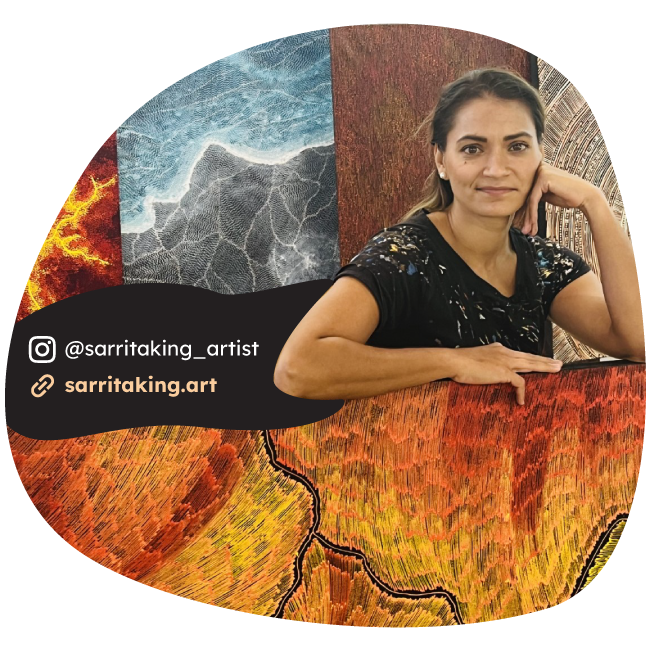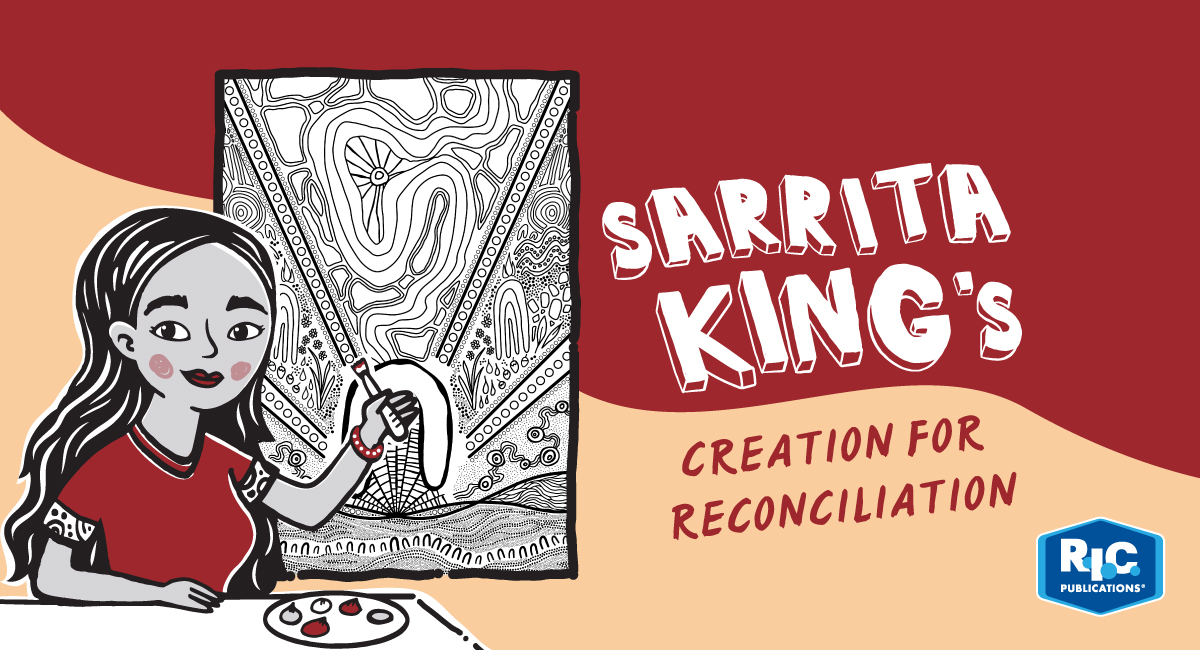- Friday 19 May 2023
- 0 Comments
National Reconciliation Week 2023 is a time for all Australians to learn about our shared histories, cultures, identities, and achievements, and to explore how each of us can work towards achieving reconciliation in Australia.
We are excited to announce that, for this year’s Reconciliation Week, we are working with the celebrated Gurindji Waanyi artist, Sarrita King, to encourage the recognition of First Nations Australians’ histories and cultures in our younger generation. Sarrita has created beautiful, unique artwork exclusively for R.I.C. Publications®, to promote the significance of the journey to reconciliation in our nation. We are absolutely honoured to be able to collaborate with such an influential—and talented—figure in her field.
Click here to download your Sarrita King Reconciliation Week art pack
We have carefully designed a series of freebies—one for each day during Reconciliation Week, plus a few exciting extras—centred around Sarrita’s artwork, to encourage further exploration of the importance of achieving reconciliation. We want educators to use these freebies to support the teaching of reconciliation and empower kids to use their voice and their words to work towards a better Australia for all. At the end of the week, all the freebies we’ve compiled can be found in this blog post.
As educators, we understand the importance of ensuring all of our students are represented and heard in the classroom. This is why our team believes it is so vital for us to create meaningful connections and opportunities for collaboration with experts in a range of fields. For our latest project, our team—in collaboration with Sarrita—has thoughtfully designed each freebie and seized this incredible opportunity to explore how we can continue to work towards achieving reconciliation in our nation.
As we’re sure you all know, we absolutely love creating freebies for all kinds of educators and we’re excited to be able to provide another range of freebies to acknowledge such an important journey—join us in recognising those that came before us.
The meaning of Sarrita’s artwork
While collaborating on this project with Sarrita, we had the absolute pleasure of sitting down with her to discuss what her artwork represents and her thoughts on this year’s Reconciliation Week theme.
Sarrita shares how to interpret her artwork and use it to explore, and voice, each student’s past, present, and path into the future. So, what does Sarrita’s artwork signify?
‘The central motif is a person; flowing around them is the past, present, and future,’ Sarrita says. ‘Under the person, the land reflects the ancestors that have come before, who hold us up and still have impacts via family lines. Moving up, the travelling lines highlight the distance travelled through life, and memories of moving house to house, or even country to country.
‘The web moving into the person is the foundation and dreams of family, and the ancestors flowing into them. Above this, the image moves through the beauty of our surroundings—the elements of landscapes, nature, and food that we all recognise, and that shape our own connections.
‘The centre section is all coming from the middle person—this is the path leading outwards and onwards into the future, with the landscape flowing off it. My intention in this section is to have others fill these open sections with their own dreams, what they are passionate about, their loved ones, and their community. This section is how they want their voice to go out into the world.’
Through speaking with Sarrita, it quickly becomes evident that she strongly believes in the power art possesses to shape our experiences and to capture the beauty of the natural world around us. Born as the second daughter of the great Indigenous artist, William King, Sarrita started painting when she was 16 years old and, while developing her own style, eagerly embraced the creative outlet it gave her.
‘Children expressing creatively is very important as it is the purest expression of imagination—a way to express dreams, desires, learning and fun,’ Sarrita says. ‘Through this freedom, they can weave parts of it into their everyday life, creating a mind that is not limited by social constructs and norms.’
So, how does Sarrita interpret this year’s theme, ‘Be a voice for generations’?
The 2023 Reconciliation Week theme encourages all Australians to use their power, their words and their vote to create a better, more just Australia for all of us.
‘The theme “Be a voice for generations” is about taking up the mantle for your family—for young people to step into their voice and speak up, to make changes and be a part of a positive legacy,’ Sarrita says.
In this way, reconciliation must live in the hearts, minds, and actions of all Australians as we continue to move forward and create respectful relationships between Aboriginal and Torres Strait Islander peoples and non-Indigenous peoples.
Sarrita also encourages all of us to ‘lead with kindness, inclusion and innovation when stepping into the future, whilst acknowledging those who brought us into this life.’
Reconciliation Week takes place, as it does every year, on 27 May–3 June, which commemorates two important milestones in the reconciliation journey in Australia. The first, on 27 May 1967, is the day Australia’s most successful referendum took place, as over 90 percent of people voted to give the Australian Government the power to make laws for Aboriginal and Torres Strait Islander peoples and include them in the Census.
The second date, 3 June 1992, marks the day the High Court delivered the Mabo decision, the result of Eddie Koiki Mabo’s challenge to the legal fiction of ‘terra nullius’ (land belonging to no one). This led to the legal recognition of Aboriginal and Torres Strait Islander peoples as the Traditional Owners and Custodians of lands, which paved the way for Native Title.
Acknowledging these milestones is an important step in the road to reconciliation—respecting and exploring the histories of those that came before us allows a deeper understanding of the world we live in today.
Sarrita’s art philosophy
Creative outlets often allow us to process and reflect on important aspect of our lives—including history, culture, and society. Understanding of the world around us is deeply rooted in many artists’ work—Sarrita’s included.
Her work explores the numerous stories the land has to tell. She aims to peel back the layers of the elements and nature that surrounds her, and unlock deeper meaning.
‘My philosophy is very much taken from my father’s art and life philosophy,’ Sarrita says. ‘And that is to share stories and build connection via shared experiences. Capturing the beauty of nature, the elements, and life to bring the viewer into their own culture and heritage. Through this process, I feel connected to my own cultural identity, past, and the future that I am creating for myself and my family.’
Continuing the journey towards reconciliation
This Reconciliation Week—and in the weeks beyond—we encourage you to explore the histories and cultures of First Nations Australians and the journey to reconciliation that we must all continue to work towards. We hope our freebies compliment your teaching of reconciliation—and light up your classroom, of course!
Click here to download your Sarrita King Reconciliation Week art pack
We can’t wait to see them in your hands!

Sarrita King is a renowned Indigenous Australian artist from the Northern Territory and part of the Gurindji tribe. She began painting when she was 16 and her art has received international acclaim throughout her career. You can find out more about her story and artwork at https://sarritaking.art/ and on her Instagram, @sarritaking_artist.
